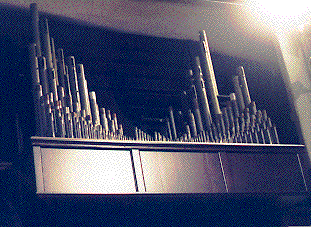 The Austin at St. Luke's Episcopal Church: Click for a larger view.
The Austin at St. Luke's Episcopal Church: Click for a larger view.
 The Austin at St. Luke's Episcopal Church: Click for a larger view.
The Austin at St. Luke's Episcopal Church: Click for a larger view.
This is the windchest and pipes of the Great division (middle manual) of the organ on which I took lessons for nearly twelve years, a three manual Austin at St. Luke's Episcopal Church, in downtown Long Beach.
Here I am at the console of that selfsame organ. Note that this picture was obviously staged; the lights over the music desk are out, and not a single stop is drawn!
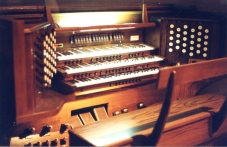 The new console. Click for a larger view.
The new console. Click for a larger view.
In 2003, after a successful fundraising campaign I helped produce, St. Luke's replaced the aging console, over 45 years old, with this new console by Schantz, including "prepared-for" stops, a more modern combination action, and a MIDI interface.
In 2009, for reasons I'm not at liberty to discuss in detail, my lessons were moved to Covenant Presbyterian, just a few blocks down 7th Street, on the hospitality of the church's organist, Peter Bates. For most lessons, I have a choice of either a large organ of mixed parentage in the Nave (which I jokingly refer to as a "Murray Harris, Aeolian-Skinner, Merrill Lynch, Pierce, Sacco and Vanzetti"; apologies to George Carlin), or a small Schlicker, evidently originally built as a practice organ, in the Chapel. The latter, shown at the right is my usual choice; while it's hardly a tracker (and indeed, is almost as heavily unified as a theatre organ), it does have a certain intimacy that I find appealing. Rather interestingly, the swell pedal is a dummy; it doesn't even move.
My teacher's other student at Covenant Presbyterian prefers the Nave organ. To me, it's a bit too large, and too Romantic in character, and even though it has a good deal more resources than the Chapel organ, I actually find it more frustrating to register, because of the way those resources are allocated.
As always, click any of the pictures for a larger version.
Here is my "makeshift lashup." The keyboard is a Roland E28; the MIDI box is a Generalmusic/Ahlborn Archive 201; the small box on top of it is an Alesis Nanoverb reverb unit. The box plays through my stereo system. This is the 1877 Johnson & Son tracker organ (2 manuals, 22 ranks) at St. Paul's Episcopal Church, Sacramento, CA. On my 1997 vacation, and when I returned on my 1999 vacation, I not only got to hear and photograph this instrument, I also had the opportunity to play it, briefly. The organist, David Robbins, is shown here, installing a fan over the console (it was a very hot Sunday in Sacramento). Below: The console of the Johnson & Son at St. Paul's. Both key and stop action are direct tracker.
Maestro Robbins allowed me to take some pictures inside the chamber in which the organ resides. This is the 1969 Flentrop tracker organ (2 manuals, 22 ranks) at All Saints' Episcopal Church, Palo Alto, CA. On my 1997 vacation, I not only got to hear and photograph this instrument, I also had the opportunity to meet Maestra Gwen Adams, who was retiring from her position as organist and choir director, and who had recorded an album (currently out-of-print) of music by Johann Ludwig Krebs. (The current organist/music director is Maestro Albert Campbell, who was kind enough to permit me to try the organ for a few minutes, when I visited again on my 1999 vacation.) About the organ, I can only say that it sounds as scrumptious as it looks. Below: The console of the Flentrop at All Saints'. Both key and stop action are direct tracker.
Inside the slots (actually sliding swell shutters) in the doors, you can see the pipes of the Brustwerk division. Above are the Hauptwerk facade pipes.
This is the 1965 Flentrop tracker organ (4 manuals, 79 ranks) at St. Mark's Cathedral (Episcopal), in Seattle, Washington. On my 1999 vacation, I had the opportunity to not only hear and photograph it but to spend over two hours playing it, courtesy of Dr. J. Melvin Butler, the staff organist and music director. Below: The console and Brustwerk of the Flentrop at St. Mark's. Key action is direct suspended tracker, and stop and combination actions are electric.
Click for a larger view (now hosted on Flickr) The St. Mark's Cathedral Flentrop is truly a joy to play. The specification is available online, on the Flentrop Orgelbouw web site.
Here I am, playing the Visser-Rowland tracker organ at the Parish Church of St. Richard of Chichester (Episcopal), in Winter Park, FL. On my 2000 and 2002 Fall vacations, I had the opportunity to play it after the Sunday morning service, courtesy of Bradford Gee (in 2000) and Bob Miller (in 2002), the former and current staff organists. Pieter Visser, the builder, recommended this organ to me. Because the pipework is so close, it presents an unusual challenge to play. Below: The pipework of the Visser-Rowland, looking up from the console.
Click for a larger view Below is a view of the entire organ at St. Richard's. Some of the facade pipes (just below the two Chamade clusters) are hung upside down.
Below are the organs at three churches I visited on my fall 2003 vacation: On the left is the 1888 Johnson at Lincoln Park Presbyterian, in Chicago, next is the 1903 Hook & Hastings, at "Old Swedes'" (Gloria Dei) Episcopal, in Philadelphia, and on the right is the 1977 Robert Sipe (incorporating some E.M. Skinner pipework) at First Presbyterian, Dallas. As usual, click on either picture for a closer view.
My Fall, 2007 vacation took me to Washington DC (my first real visit, although I'd spent about an hour there in 2004, while waiting for a connecting train), where I visited St. Columba's Episcopal Church, with its delightful 1981 Flentrop. (Specs, in Dutch, here)
In 2009, I split my Spring vacation in two, first visiting the Soutwest for a week. First, I spent a day in Tucson, AZ, not to visit an organ, but an organist: that's where Dr. Pamela Decker, organist, professor, and composer, makes her home. After the service at Grace St. Paul's Episcopal Church, she was kind enough to spend far more time "talking shop" with me than I deserved (even keeping a student waiting, in the process). But I didn't even get a picture of Dr. Decker (the one that ended up in my vacation album was from Maxine Thevenot's web site!). In the Fall of 2009, though, I spent most of a day in Denver, Colorado, visiting Our Merciful Savior Episcopal Church, which has the only non-academic tracker organ in town (pictured), before seeing Mount Rushmore, then visiting my grandmother in North Dakota, and going on to Minneapolis, Chicago (where my picture of the Martin Pasi organ at St. Paul and the Redeemer Episcopal Church didn't turn out), and Ann Arbor.
I'd visited Lutheran of Honolulu in 2005, but Holy Innocents' was new to me. I had only a short time at both churches: in Honolulu, I had to find lunch, then catch a bus to the local railroad museum (where they saw me coming, and held the last excursion train for me!), while in Lahaina, I had a submarine to catch.
At Holy Innocents', I actually came on a day when they held the service on the back lawn, but the Rector had been told of my visit, and was more than happy to give me some time with the organ.
My "Wave Organ" page What exactly is the Wave Organ? Find out here.
This entire site is composed mainly of what Synthesist/Composer Wendy Carlos refers to as "living pages."
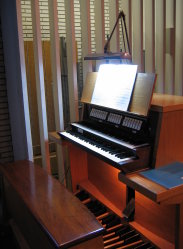

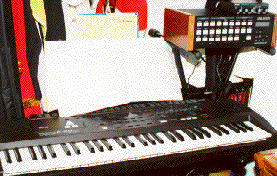 Click for a larger view (now hosted on Flickr)
Click for a larger view (now hosted on Flickr)
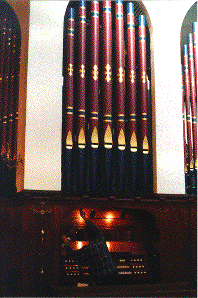 The Johnson and Son Organ at St. Paul's Episcopal Church: Click for a larger view
The Johnson and Son Organ at St. Paul's Episcopal Church: Click for a larger view
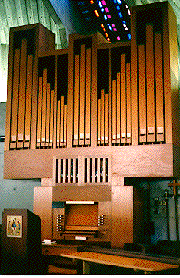 The Flentrop Organ at All Saints' Episcopal Church: Click for a larger view
The Flentrop Organ at All Saints' Episcopal Church: Click for a larger view
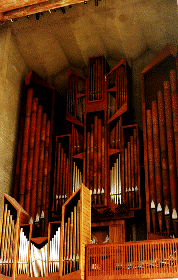 The Flentrop Organ at St. Mark's Cathedral: Click for a larger view (now hosted by Flickr)
The Flentrop Organ at St. Mark's Cathedral: Click for a larger view (now hosted by Flickr)
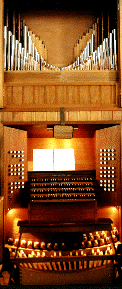
Click for a larger view (now hosted by Flickr)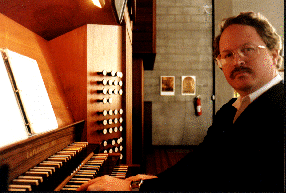
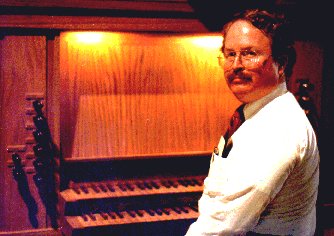 The Visser-Rowland Organ at St. Richard's: Click for a larger view
The Visser-Rowland Organ at St. Richard's: Click for a larger view
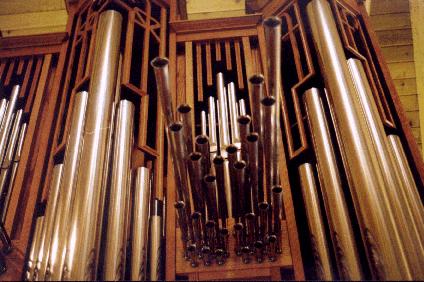
Note the Trompette en Chamade rank, rather unusual for an organ of such relatively modest size.
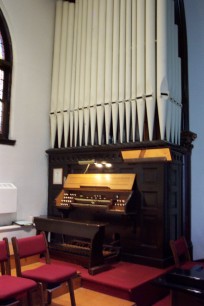
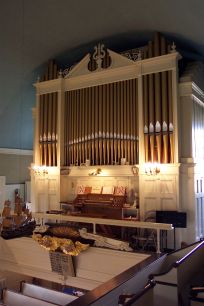

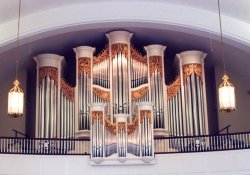
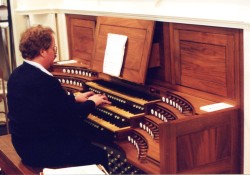 Also during my 2003 stay in Philadelphia, the late Malcolm Wechsler, the U.S. representative for Mander Organs, arranged a demonstration and tour of the Mander at Chestnut Hill Presbyterian Church, about half an hour away from Philadelpha, by commuter train.
As always, click either picture for a closer view.
Also during my 2003 stay in Philadelphia, the late Malcolm Wechsler, the U.S. representative for Mander Organs, arranged a demonstration and tour of the Mander at Chestnut Hill Presbyterian Church, about half an hour away from Philadelpha, by commuter train.
As always, click either picture for a closer view.

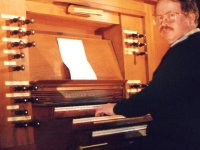 In the Spring of 2004, instead of visiting the Bay Area, I made my first trip to Boston, and had an opportunity to spend a good chunk of one morning with what, for tracker-backers and E. Power Biggs fans, is probably the ultimate "pilgrimmage organ" in North America: the 1958 Flentrop, that Biggs installed at Harvard university, in what was then simply called the "German Museum" (now Adolphus Busch Hall), at his own personal expense. When class is in session at Harvard, there is usually a free lunchtime recital every Thursday. The specification is available online, on the Flentrop Orgelbouw web site.As always, click either picture for a closer look.
In the Spring of 2004, instead of visiting the Bay Area, I made my first trip to Boston, and had an opportunity to spend a good chunk of one morning with what, for tracker-backers and E. Power Biggs fans, is probably the ultimate "pilgrimmage organ" in North America: the 1958 Flentrop, that Biggs installed at Harvard university, in what was then simply called the "German Museum" (now Adolphus Busch Hall), at his own personal expense. When class is in session at Harvard, there is usually a free lunchtime recital every Thursday. The specification is available online, on the Flentrop Orgelbouw web site.As always, click either picture for a closer look.
 Unfortunately, none of the pictures I took of organs in 2006 exist, thanks to my having lost my first digital camera somewhere in New Haven.
Unfortunately, none of the pictures I took of organs in 2006 exist, thanks to my having lost my first digital camera somewhere in New Haven.

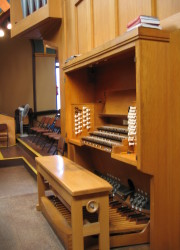 In Fall of 2008, I made my first visit to New York City, as well as my second to Philadelphia, and a brief third visit to Boston. My one picture of the organ at "The Little Church Around the Corner" did not turn out well at all (which is just as well, as the instrument was shrouded in plastic at the time, because of a great deal of construction in the church), but the pictures of the von Beckerath at St. Michael's Episcopal turned out quite well indeed. The facade of this one reminds me a bit of that of the St. Mark's (Seattle) Flentrop.
In Fall of 2008, I made my first visit to New York City, as well as my second to Philadelphia, and a brief third visit to Boston. My one picture of the organ at "The Little Church Around the Corner" did not turn out well at all (which is just as well, as the instrument was shrouded in plastic at the time, because of a great deal of construction in the church), but the pictures of the von Beckerath at St. Michael's Episcopal turned out quite well indeed. The facade of this one reminds me a bit of that of the St. Mark's (Seattle) Flentrop.
 Then I visited Dallas (this time, staying long enough to visit the Zoo, as well as several museums), Oklahoma City, and the Grand Canyon. A few weeks later, I did my usual Bay Area vacation.
Then I visited Dallas (this time, staying long enough to visit the Zoo, as well as several museums), Oklahoma City, and the Grand Canyon. A few weeks later, I did my usual Bay Area vacation.
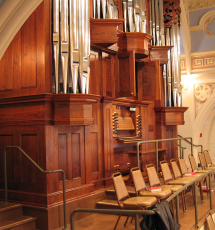
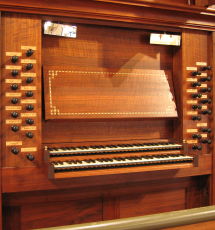 In the Spring of 2010, I had two Sundays in the Bay Area, and a chance to visit St. Mark's Lutheran (ELCA) for the second time (and to try the Taylor & Boody for the first time). I'd been there once before, the last time I'd been in the Bay Area on two Sundays (I always visit All Saints').
In the Spring of 2010, I had two Sundays in the Bay Area, and a chance to visit St. Mark's Lutheran (ELCA) for the second time (and to try the Taylor & Boody for the first time). I'd been there once before, the last time I'd been in the Bay Area on two Sundays (I always visit All Saints').
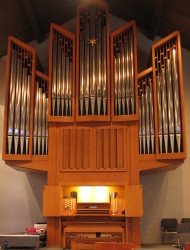
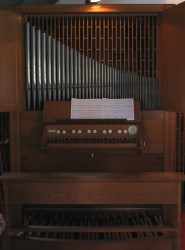 In the Fall of 2010, I made my second trip to Hawaii, and this time, I remembered to get pictures of both the Lutheran of Honolulu (ELCA) von Beckerath (left), and the Holy Innocents' Episcopal (Lahaina) von Beckerath (right). The Holy Innocents' organ was actually Lutheran of Honolulu's first von Beckerath, but was too small for the church (but ideally suited to the much smaller Lahaina church).
In the Fall of 2010, I made my second trip to Hawaii, and this time, I remembered to get pictures of both the Lutheran of Honolulu (ELCA) von Beckerath (left), and the Holy Innocents' Episcopal (Lahaina) von Beckerath (right). The Holy Innocents' organ was actually Lutheran of Honolulu's first von Beckerath, but was too small for the church (but ideally suited to the much smaller Lahaina church).
![]() Drumming Up Interest
is an essay I wrote for the PIPORG-L list server, on why there is currently such a lack of interest in organ music. Publisher inquiries are welcome!
Drumming Up Interest
is an essay I wrote for the PIPORG-L list server, on why there is currently such a lack of interest in organ music. Publisher inquiries are welcome!
![]() Introducing Jennifer
is one of nearly a dozen (to date) short stories (and a novel) about the adventures of a child prodigy organist. Publisher inquiries are welcome!
Introducing Jennifer
is one of nearly a dozen (to date) short stories (and a novel) about the adventures of a child prodigy organist. Publisher inquiries are welcome!
![]() My Organ Links
My Organ Links
My organ links page contains links to a growing list of interesting organ-related web sites.
![]() Organ Jokes
Organ Jokes
Warning: My organ joke page is just a bit acid-tongued towards Hammonds.

Adventures in Creative Futility: Organ Lessons on Only One Semester of Piano!

My first student organ recital, June 21, 1998 (INCLUDING SCORE!)
![]() My CD Reviews Page (the organ music CDs)
My CD Reviews Page (the organ music CDs)
![]() My Christmas Organ CD Reviews Page
My Christmas Organ CD Reviews Page
Not reviews of Christmas CDs, but of CDs auditioned and ordered, in quantity, as Christmas presents
It's legitimate. It's worthy.
![]() And it doesn't cost you a dime.
And it doesn't cost you a dime.![]() Back Home
James H. H. Lampert
Copyright © James H. H. Lampert, 1997-2011
Back Home
James H. H. Lampert
Copyright © James H. H. Lampert, 1997-2011
Revised Friday, November 20, 2015
This Page URL: http://members.toast.net/JHHL/Music/Organ/Organ.html
Home Page URL: http:/members.toast.net/JHHL/index.html

![]()
So put on an E. Power Biggs CD, and enjoy!